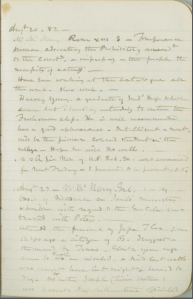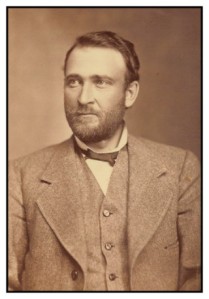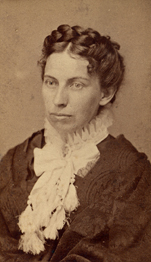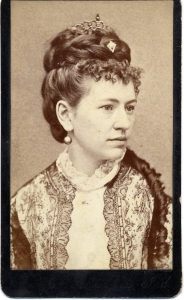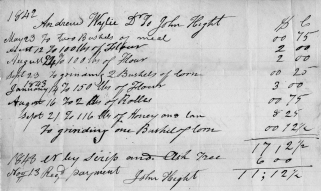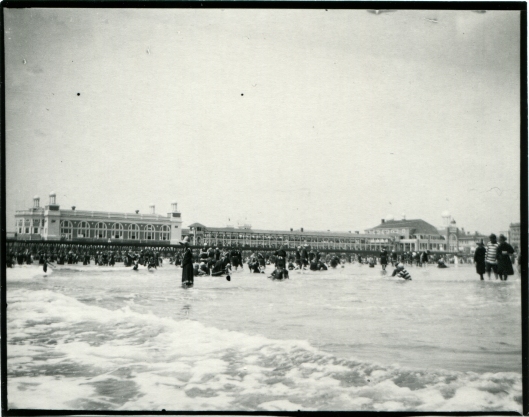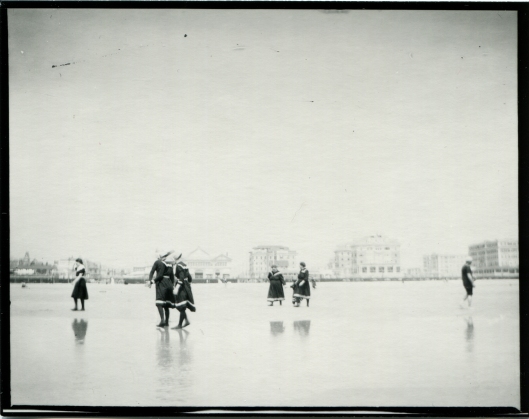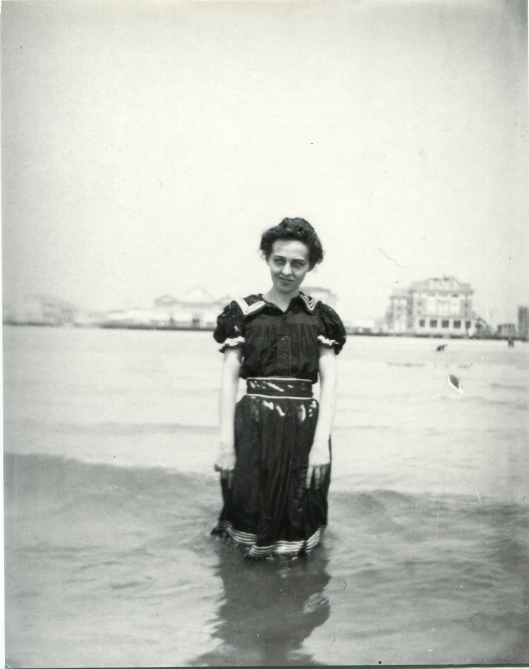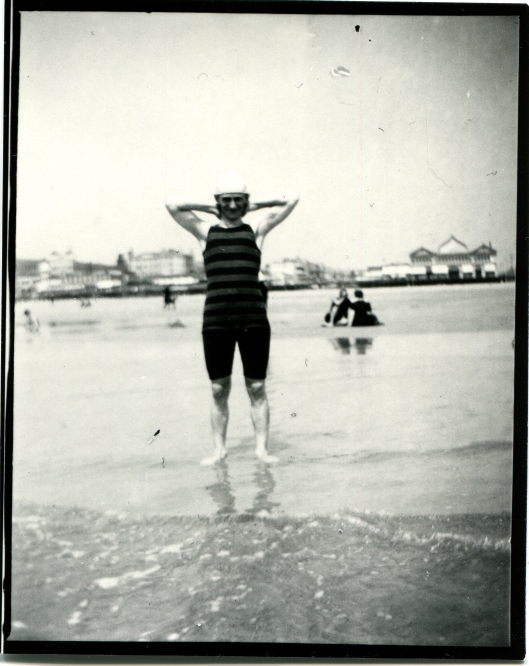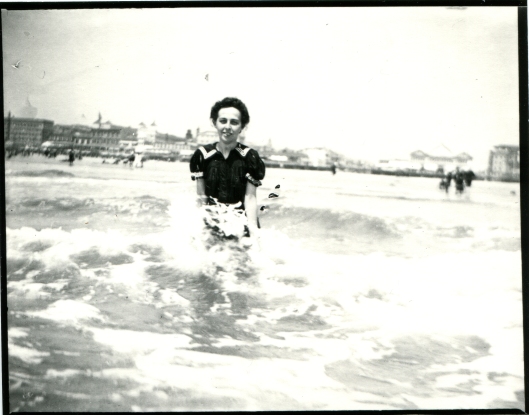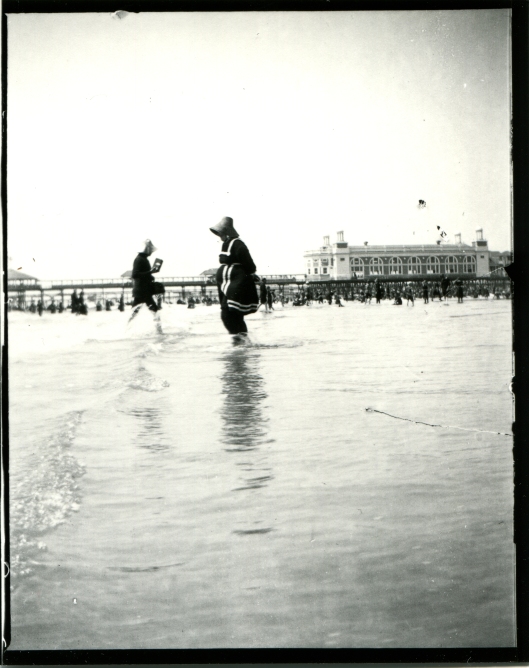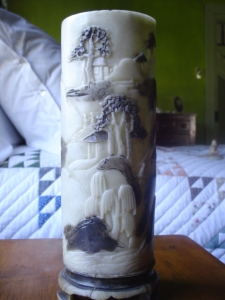Among our thousands of Wylie family correspondence are numerous letters between Marie Boisen Bradley and Morton C. Bradley. Marie was the granddaughter of Theophilus and Rebecca Wylie. Morton and Marie met early on in their time as students at Indiana University and soon began courting. The two graduated from IU in 1900 and were married that same July. Two children were born to the couple, a daughter, Louise in 1908, and a son, Morton Jr. (known as Bob to family and close friends), in 1912.
The pair wrote each other letters any time they had to be separated. The letters written between Marie and Morton are touching as they describe the depth of their feelings for one another and how much they miss the other and long to be together. These letters are lovely examples of the kinds of love letters sent by couples in this time period. Below is just a small sampling of excerpts from a selection of their letters.
 Excerpts of letter from Morton Bradley to Miss Marie Boisen [July 10, 1896]
Excerpts of letter from Morton Bradley to Miss Marie Boisen [July 10, 1896]
“I was talking to my half sister. She said that she was in a crowd where my name was mentioned in connection with a girl’s here in town—somebody was wondering if I would not go with a girl here. Then someone else spoke up and said, “You needn’t worry about him going with anyone here. He has a girl in Bloomington who is the nicest, most intellectual and highest respected girl there. He’ll not go with any girl here unless it is to pass away the time.” O, how good that made me feel! … But the compliments I have heard on you since I have been back! Just last evening one of the boys was looking at my pictures. He picked up one of yours and said “Say, there’s a pretty girl. I’ll bet she’s a nice girl.” And of course I assured him that he had struck the keynote. And he had.”
Excerpts of letter from Morton C. Bradley to Miss Marie Boisen [postmarked July 26, 1898]
“Sweetheart, although I have been away from you a very short time it seems as if months had passed since you said, “I’m so glad you came. Good bye, dear.” Do you know, dearest, that your saying that made me so happy that even now I can see you standing there with your hand in mine and your eyes telling me how much you loved me. I wanted so much to turn and tell the cabman that I wouldn’t need him, then take you in my arms and tell you that I couldn’t go, that I would stay another day. But, I knew that the parting then would be just as hard, even harder.”
Excerpts of letter from Morton C. Bradley to Marie Boisen [Monday, 22 January 1900]
“I thanked God that He had given you to me to love and to make happy. I thanked Him that you loved me and that I loved you in the same way—with the whole heart. You had promised to be my wife and I was happy—so happy. You had changed my life; you had taught me to live a better life and I was grateful to you. You were a woman and I admired you. You had character and I loved you. You were my sweetheart and I worshipped you.
And now a year has passed. I still am grateful; I still admire you; I still love you; I still worship my darling sweetheart. And all to a greater degree than a year ago. But how can I write them stronger? I feel them—I know that my whole heart’s love, my whole life, my whole being is yours and will always be. I know that my entire happiness depends on you, dearest. I know that I wish more than for anything else that we were married—that you were now the darling wife I know you will be.
Five months, and less! My dearest, I am so anxious for our wedding day to come that were it right I would wish them gone. But still there is a sweetness in the waiting. I know I dearly love to talk to you about our wedding in blissful anticipation of the happiness I pray for. God willing, we shall be happy, my sweetheart. I will devote my life to your happiness. In doing that I know He will be pleased. For you will want me to live a Christian life.
And now that our perfect happiness is so near, I am trying more than ever to be what you want me to be. I will be what your husband should be. My darling, you deserve the very best husband in the world. And with His help, I will be that.”
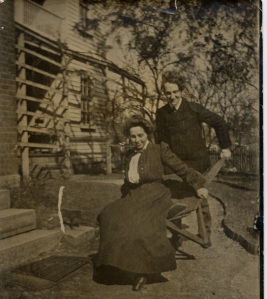
Marie and Morton outside the front of Wylie House.
Excerpts of letter from Marie Boisen Bradley to Mr. Morton C. Bradley [Postmarked May 14, 1901]
“You will forgive the writing, won’t you? My position is not conducive to expert penmanship, but I love you just the same.
Dear heart, I am so sorry that you have had to go these three days without a letter from me. You know, don’t you, that if I could possibly have written I would have done so? I did all that I could—had mamma write and I hope that her letters kept you from being uneasy. Dear boy, you mustn’t be one bit uneasy now, though, for I am really and truly getting well quickly. I feel so well today. I don’t see how I will ever manage to stay in bed for ten days, but of course if it is for the best I will try to be patient. I want to get up entirely well and I know that the only way to do that is to stay in bed for a while.
Do write to me as often as you can, dear. Your letters will mean more than ever to me now that I have nothing to do but to be here and think.
Tomorrow I will try to write a longer, better letter. Now I wish I could see you, dearest. I am thinking about you all the time. I love you with my life. “
Excerpts of letter from Marie B. Bradley to Mr. Morton C. Bradley [Postmarked Oct 20, 1903]
“Everyone sends dearest love to you, and all wish that you could have come. But most of all Mrs. wishes that! My heart was pretty heavy, dear one, when I found myself speeding westward past the billy goats grazing on the out skirts of Jersey City. But I’ve kind of picked up heart now, and much as I miss you, I intend to have a fine time, so that we will both be glad I came. Darling, I love you. Next time, which will be tomorrow, I will write a longer letter. Tonight circumstances are against me. I am down in the dining room and while the folks are trying to keep still it simply has to bubble over every so often. They all do seem so glad to see me dearest!
May God bless and keep you, my precious love. I am now, and will ever be
Your own true
Maidie-wifen”

No idea what is happening in this picture, but it’s one of my favorites.
Excerpts of letter from Marie B. Bradley to Mr. Morton C. Bradley [October 21, 1903]
“If only a letter comes from you tomorrow! I have so longed for one today. It seems a long time since I have had any word from my precious boy.
Everyone is impressed with the fact that I look so well. (I think too, dear, that my brown suit has made a profound impression.) I have felt so well today. It has been a heavenly day, a splendid Indian summer day. The country is wonderfully beautiful just now and the fine air is exhilarating.
But how I long for you! My heart is with you all the time. I am thinking, thinking, thinking of you all day. May God bless and keep you for me, dear one. He alone knows how I love you and long for you.
Tomorrow! I can hardly wait, for tomorrow, I know, will bring me one of your precious letters.
My heart’s love to you
I am, your own
Marie
A thousand kisses to you”
Morton C. Bradley, Boston, Mass. to Mrs. M. C. Bradley, 307 E. 2nd St. Bloomington, Indiana [postmarked Sept 27, 1905]
“I believe this letter will reach you on your birth anniversary. But whether it does or not it’s my birthday letter to you, my sweetheart-wife. I couldn’t think of letting the day go by without telling you at least some of the things my heart prompts me to say. And especially this year I must write you such a letter. For whatever of happy days the other years have brought you the one just beginning gives promise of greater happiness and completer contentment than any we’ve known. And we have been happy these other years, my sweetheart. It’s true, there have been times when we would have had conditions different. And yet through it all we’ve been happy. We had each other and we knew absolutely each other’s love—why shouldn’t we be happy? We knew each other and we loved completely and our hearts were happy. Those are the important things. Other conditions change, there are ups and downs, dark days and bright. But love, if it is love, changes only in that it grows more intense. And it is love only if it becomes more complete regardless of the changing conditions.
Such a love, my sweetheart, is mine for you. It has always seemed to me that my love for you was so great, so complete, that it wouldn’t be possible for anyone to love another with a greater or a more devoted love. And yet as the months go by and when new years begin, I realize that my love for my precious sweetheart wife has become more complete, more intense.
 Now, I firmly believe that no one can inspire a real love, nor can anyone encourage any love to really grow unless that person is truly worthy of that love, and that never is the love greater than that person’s worth. Only good is truly loved and only to the extent that it is really good. To see good is to love it; it is only necessary to recognize it. The greater one realizes the good to be, the greater his love for it. My love for you, dearest one, has become greater every day. It’s simply that I have known you better every day. That my love should become more intense was only natural. My heart’s love today, sweetheart, great as it is, is all yours, my very life is just for you and your happiness.
Now, I firmly believe that no one can inspire a real love, nor can anyone encourage any love to really grow unless that person is truly worthy of that love, and that never is the love greater than that person’s worth. Only good is truly loved and only to the extent that it is really good. To see good is to love it; it is only necessary to recognize it. The greater one realizes the good to be, the greater his love for it. My love for you, dearest one, has become greater every day. It’s simply that I have known you better every day. That my love should become more intense was only natural. My heart’s love today, sweetheart, great as it is, is all yours, my very life is just for you and your happiness.
Confident as I am that my love for you, my truly lovable wife, will become greater this coming year. I am just as confident that your happiness this year will be a more complete, a more contented, happiness. I believe we both can more correctly look ahead and that we have arrived at a point where there is actually more there to be seen. I think we have “found ourselves.” If that is the case, we need but to resolve and to work. If we haven’t quite reached that point, working, I know, will mighty soon bring us there. Dearie, I’ve resolved and I’m working. The results must come and they must be results commensurate with our abilities. And we know what they are, which means that we know the results not to accomplish which will mean disappointment to us. And neither of us will ever be satisfied with disappointments.”
Happy Valentine’s Day!
-Allison Haack, Graduate Student Volunteer






